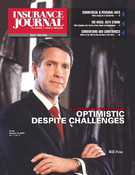Fitch Ratings assigned a “BBB” long-term rating to RLI Corp. (RLI) and a “BBB” rating to RLI’s 5.95 percent senior unsecured notes due in 2014. In addition, Fitch assigned “A” financial strength ratings to RLI’s subsidiaries, RLI Insurance Company and Mt. Hawley Insurance Co. The rating outlook is stable.
Fitch’s rating reflects RLI’s consistently strong underwriting profitability, moderate financial leverage, and strong earnings base and cash basis interest coverage. Partially offsetting is RLI’s high reinsurance leverage, concentrated premium production in the catastrophe-exposed states of California and Texas, and potential surplus volatility derived from the company’s comparatively high investment portfolio allocation to equities.
Fitch views RLI as a moderately sized niche-oriented commercial insurer whose key competitors typically have more resources and larger capital bases. The company competes in this environment by tailoring products and coverages for underserved markets. RLI reported GAAP basis net premiums earned of $342 million through the first nine months of 2003 and GAAP basis equity of $527 million at Sept. 30, 2003.
RLI has historically reported very strong underwriting profitability and Fitch believes that these results are likely to continue in the near term. Between 1992 and 2002 the company’s statutory combined ratio averaged a low 95.4 percent and in recent years RLI’s combined ratio has consistently been 10 to 15 points lower than the commercial line’s industry average.
Fitch attributes RLI’s superior underwriting results to the company’s consistent focus on managing each of its various books of business to individually generate underwriting profits. Fitch also believes that RLI’s practice of employing experienced underwriters and basing their compensation, in part, on the profitability of their book of business over comparatively long periods of time, contributes to the company’s superior underwriting profitability.
RLI uses a significant amount of reinsurance to manage its capital and its exposure to large losses. This translates into above industry average surplus exposure to reinsurance recoverables and heightened exposure to reinsurance market competitive conditions.
In 2002 the company retained a comparatively low 59 percent of its gross premium and at year-end 2002, RLI’s ratio of reinsurance recoverables to surplus was 114 percent compared to the industry average of 57 percent. This exposure is mitigated somewhat by the generally high credit-quality of RLI’s reinsurers. In addition, RLI has stated that one of the potential uses of the proceeds from its recent debt offer is to selectively reduce its reliance on reinsurance.
RLI generated 36 percent of its 2002 direct premiums written in California and Texas, which is significantly higher than the industry’s percentage of total premiums generated in these two states. As a result, the company has comparatively high exposure to potential earthquake and hurricane related losses.
RLI has consistently invested a relatively large portion of its investment portfolio in equities. This strategy is consistent with one of the company’s stated goals of growing book value over the long-term, but it exposes RLI’s surplus to greater volatility than a more conventional allocation. Fitch noted that RLI maintains strong liquidity characteristics due to its strong operating cash flow and high quality publicly traded bond portfolio.
Topics Underwriting Reinsurance
Was this article valuable?
Here are more articles you may enjoy.


 BlackSuit Cybercrime Gang Blamed in CDK Hack That Roiled Car Dealers
BlackSuit Cybercrime Gang Blamed in CDK Hack That Roiled Car Dealers  Big ‘I’ Report: Independent Agency Channel Placed 62% of Premiums in 2023
Big ‘I’ Report: Independent Agency Channel Placed 62% of Premiums in 2023  Ryan Specialty Announces Succession Plan: Pat Ryan to Exec Chair, Turner to Be CEO
Ryan Specialty Announces Succession Plan: Pat Ryan to Exec Chair, Turner to Be CEO  Three Charged With Helping Agents Cheat on Florida Insurance License Exams
Three Charged With Helping Agents Cheat on Florida Insurance License Exams 


